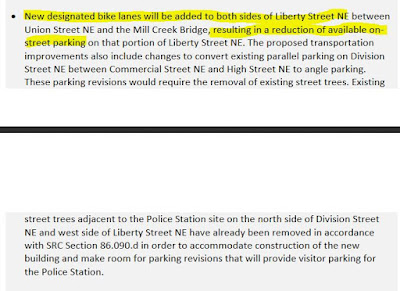Our local Metropolitan Planning Organization meets on Tuesday to prepare the way for the public draft of the 2019 Regional Transportation System Plan and its formal Public Comment period.
There are some other topics to note in passing also.
The full Public Draft of the RTSP looks to go before the committee next month to be approved for a formal public release. Then in May they'll hold a public hearing and vote on adoption. This month they'll look at Chapter 7 with the project lists, Chapter 8 on impacts, and the Executive Summary. Next month we'll see the whole. (Chapter 8 was not in the meeting packet, however. So this post may be updated later. See
notes on the Technical committee's previous draft version of Chapter 8.)
This version of the RTSP comes at a transitional moment. Salem City Council finally decided for the "No Build" alternative on the SRC, and much of previous editions of the RTSP (and a wider orbit of associated planning efforts) has been premised on some kind of big build for the SRC. Salem City Council is also finally undertaking a greenhouse gas assessment, and since the transportation sector now is the largest contributor to Oregon's greenhouse gas emissions, any kind of formal evaluation of emissions will now have consequences for transportation planning. Then there is the specific matter of Goal 7, which remains contested and in particular is a site of conflict between the reactionary forces at Marion County, and new perspectives at Salem City Council.
The RTSP is ostensibly a neutral document, but it's really shot through with assumptions and enacts a particular notion of "balance."
The balance may be tested this time around, and the supporting materials read a little anxiously.
At February's meeting, just after Council's decision on the SRC, the MPO deliberated whether to delete a set-aside of $20 million for right-of-way on the SRC.
 |
| Let's keep $20 million for the SRC! |
They decided to retain the money, and not to allocate it elsewhere.
(Though in fairness, as I understand it, there are two main buckets of money, and this $20 million is in the more theoretical one involving funding projections for the future: "Committed" funds, which go out four, or sometimes six, years, are hard funding commitments on projects that are
actually being planned and built; this $20 million is not for that, but is for "included" projects and projected funds, and these are future projects
outside the four-year horizon of the firm funding commitments. It is not terribly difficult to revise funding notions on "included" projects. Retaining the $20 million for the SRC is more symbolic than actual budgeting action. Still, serious thought should be given to re-assigning it to any overages or enhancements on the Seismic Retrofit of the Center Street Bridge. That keeps it on the "crossing," but redirects it to an actual and actually useful project.)
There's also a discussion of the procedure for adoption of the RTSP, and for the first time it acknowledges that things could get sticky. Previously the adoption has been very routine, but not perhaps this year.
Will there be a showdown on Goal 7?











































